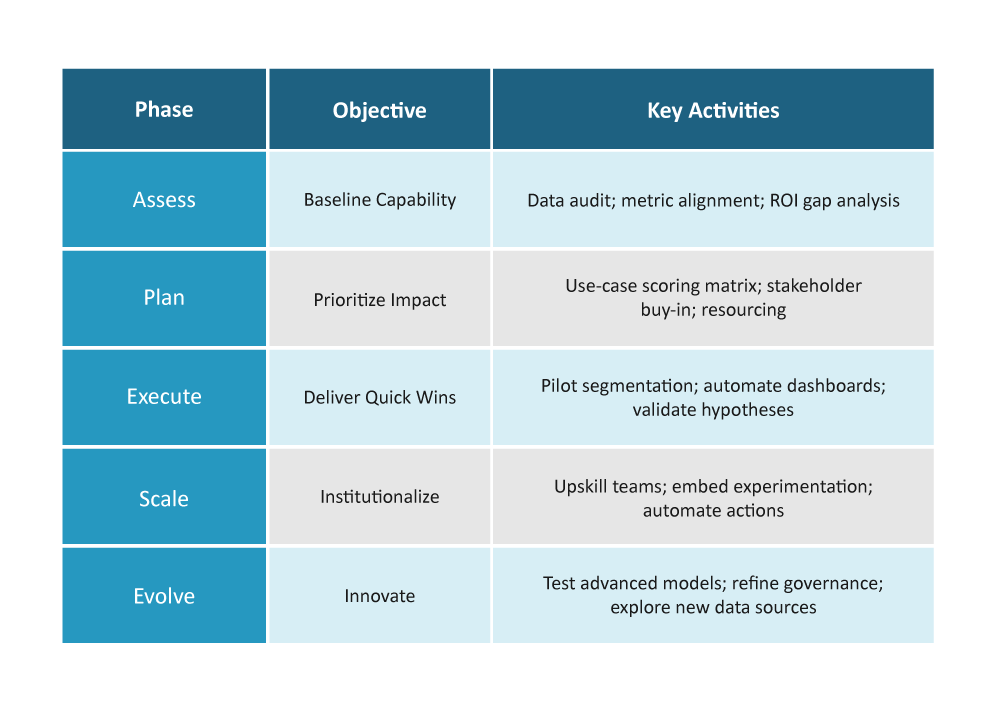Ecommerce analytics unveiling tools and strategies for maximizing growth in 2025

Highlights:
- Unified ecommerce analytics unlock real-time visibility across all customer touchpoints.
- Intelligent segmentation and predictive UX boost retention and conversions.
- Inventory forecasting reduces stockouts and frees cash for growth.
- Emerging tools like edge analytics and zero-party data redefine personalization.
- Data ethics and governance enhance loyalty and brand trust.
- A phased maturity roadmap ensures scalable, insight-led ecommerce growth.
In a digital marketplace that never sleeps, ecommerce analytics has become the central nervous system of successful online retail. Once a nice-to-have dashboard of vanity metrics, it is now a strategic discipline that integrates data from marketing, merchandising, fulfillment, and customer service to drive decisions at every level. In 2025, the brands that master ecommerce analytics will consistently outpace competitors on speed, relevance, and profitability, turning raw data into concrete competitive advantage while fueling relentless ecommerce growth.
The new data landscape
Customer journeys in 2025 span social discovery, live-stream shopping, voice search, and same-day micro-fulfillment. Each touchpoint generates signals on intent, sentiment, and context. Advanced ecommerce analytics stitches these signals together into a holistic view, revealing who shoppers are, what motivates them, and how experiences can be improved. For leadership teams focused on ecommerce growth, this unified understanding is the bedrock of smarter pricing, curated assortments, and friction-free service.
Research from Markets & Markets projects the global ecommerce analytics market will triple between 2024 and 2033, reflecting board-level commitment to data investment. Yet spend alone is not enough. Winning organizations pair technology with robust processes, domain expertise, and an experimentation culture that treats every insight as a hypothesis to validate.
Pillars of a data-mature organization
- Connected data fabric – Clean, privacy-compliant feeds from ads, onsite behavior, inventory, and post-purchase service funnel into a single source of truth.
- Clear North-star metrics – Metrics such as customer lifetime value, cost-to-serve, and net promoter score provide consistent direction across teams.
- Analytics-by-design workflows – From campaign planning to merchandising resets, analytics checkpoints are embedded, not bolted on.
- Action automation – Predictive scoring triggers merchandising swaps, retention nudges, or dynamic offers in real time, eliminating the latency between insight and action.
Brands that operationalize these pillars report 15-20% faster decision cycles and double-digit ecommerce growth within twelve months.
High-impact use cases
Intelligent segmentation and personalization
Granular segments—loyalists, seasonal splurgers, early-adopters—enable hyper-relevant messaging and product bundles. A North American beauty brand used ecommerce analytics to refine segments weekly, lifting email revenue 32 % and reducing list fatigue.
Demand forecasting and inventory optimization
Machine-learning models ingest historical sales, promotions, weather, and regional events to project demand at SKU-level accuracy. A European sportswear retailer cut stockouts by 40% and trimmed excess inventory by 35%, freeing cash for innovation.
Behaviour-driven UX optimization
Clickstream heatmaps and funnel analysis uncover where shoppers hesitate or abandon. After re-sequencing its mobile checkout flow based on analytics findings, a D2C electronics brand boosted mobile conversion by 48% and shortened average checkout time by 27 seconds.
Predictive retention
Churn-propensity scores highlight at-risk customers days before they disengage. A niche home-decor seller combined these scores with surprise-and-delight offers, generating a 25% increase in repeat purchase frequency—a clear testament to data-driven ecommerce strategies.
Case studies: Analytics in action
Case study A – FashionPure
FashionPure consolidated site behavior, loyalty program activity, and return reasons into a centralized model. Within six months, the team identified a sizing-related return hotspot and launched a fit-advisor widget. Returns dropped 18%, and average order value climbed 12% (read more).
Case study B – GearGo
Outdoor-gear marketplace GearGo focused on speed. By deploying a real-time analytics layer that surfaces inventory pressure and competitor pricing, GearGo shaved its repricing cycle from two hours to five minutes, defending margin without manual intervention (source).
Case study C – VitaHealth
VitaHealth mapped email cadence against purchase latency. Ecommerce analytics revealed that a seven-day replenishment reminder outperformed the industry-standard fourteen-day window by 19 % in conversion. The tweak added an incremental $3 million in annual revenue (case study).
Emerging analytics frontiers for 2025
- Real-time sentiment mining – Natural language processing scrapes live reviews and social comments to detect issues before formal complaints surface.
- Edge analytics at the warehouse – IoT sensors stream pick-pack-ship data, enabling immediate adjustments to staffing levels and slotting schemes.
- Privacy-preserving personalization – Federated learning trains recommendation models on-device, balancing customer relevance with regulatory compliance.
- Conversational commerce insights – Voice assistant transcripts feed into journey analytics, expanding visibility into pre-site exploration.
- Generative content intelligence – Next-generation language models auto-generate product descriptions, creative assets, and SEO variants while continuously optimizing against live performance signals.
- Sustainability & carbon footprint analytics – SKU-level lifecycle models quantify emissions and guide greener assortment choices, meeting both regulatory and consumer expectations.
- Zero-party data activation – Shoppers voluntarily share preference data through quizzes and loyalty portals, powering precise targeting without reliance on third-party cookies.
- Quantum-accelerated forecasting – Quantum-inspired algorithms solve complex demand simulations exponentially faster, unlocking near-perfect precision for promotion and replenishment planning.
Pioneers who explore these frontiers today will reap defensible differentiation tomorrow.
Building a roadmap to maturity

This staged approach ensures momentum and minimizes risk, demonstrating quick value to sponsors while laying foundations for long-term ecommerce growth.
Governance, ethics, and trust
Customer trust is the true currency of digital commerce. Robust governance frameworks keep data secure, accurate, and ethical. They encompass consent management, data minimization, and algorithmic fairness reviews. Brands that publicize transparent practices see higher sign-up rates for loyalty programs—proof that responsible ecommerce strategies enhance both reputation and revenue.
From insight to outcome: Moving ahead
The message is clear: analytics is not a dashboard, a tool, or a report. It is a management philosophy. To unlock its full potential, leaders must pair data literacy with decision-making empowerment, ensuring that insights cascade swiftly from analyst to action owner.
Firms often hesitate, fearing complexity. Yet expert partners can shoulder technical heavy lifting—data integration, model tuning, insight orchestration—allowing in-house teams to focus on creative merchandising and customer delight. In this symbiotic model, ecommerce analytics becomes the silent force powering every innovation initiative.
Conclusion
This year will crown retailers that treat data as a product and analytics as a strategic lever. By embracing data-driven ecommerce strategies—comprehensive, insight-led ecommerce strategies—intelligent segmentation, predictive forecasting, frictionless UX, and proactive retention—brands can nurture sustainable ecommerce growth while safeguarding margins. The future belongs to those ready to let insights guide the journey. For ambitious teams intent on leading, the time to invest in bespoke ecommerce analytics solutions is now.
Netscribes transforms fragmented retail data into a unified ecommerce analytics engine that delivers real-time, actionable insights across marketing, inventory, and customer experience. By combining advanced data engineering with AI-driven models, we give brands enterprise-grade intelligence without the overhead of building it in-house.






